Scottish Surveys Core Questions 2017
Official statistics publication on equality groups across a range of measures from harmonised questions in the major Scottish Government population surveys.
This document is part of a collection
2 Equality Groups
2.1 Disability: Limiting long-term physical and mental health conditions
Harmonised questions on long-term physical or mental health conditions that limit daily activity are designed to identify respondents who may have rights under section 6 of the Equality Act 2010. Limiting long-term physical or mental health conditions are therefore taken as a proxy for disability.
Table 1: Age profile of adults with limiting long-term conditions, SSCQ 2017
| Proportion in Age Group (Row %) | Adults | Col% | ||||||
|---|---|---|---|---|---|---|---|---|
| 16-24 | 25-34 | 35-44 | 45-54 | 55-64 | 65+ | |||
| Limiting condition | 8 | 8 | 10 | 16 | 19 | 39 | 1,066,021 | 24% |
| No limiting condition | 15 | 19 | 16 | 18 | 15 | 17 | 3,422,514 | 76% |
- Older people were more likely to report living with a limiting long-term health condition.
- Nearly 40% of adults who reported living with a limiting condition were aged 65+, compared with 17% of those not reporting a limiting condition.
- 14% of 16-24 year olds reported living with a limiting long-term condition, a five percentage point increase since 2012 (see Table 5.2).
Analysis
Due to the differences in age profiles of the two groups, age-standardisation is applied before comparisons are sumarised below. For more information on age-standardisation, see section 6.9. For more information about statistical tests, see section 6.10.
- General Health
Disability - Findings (age-standardised)
Those without a limiting long-term condition were nearly three times as likely to report good or very good health as those with a limiting long-term condition.
Since 2012, there has been a rise of 1.0 percentage points in good/very good general health for those with a limiting long-term condition.
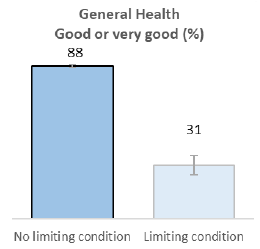
- Smoking
Smoking rates were nearly double (29%) among adults living with a limiting long-term health condition compared to those living without.
For adults with a limiting long-term health condition, smoking rates have fallen by 4.7 percentage points since 2012.
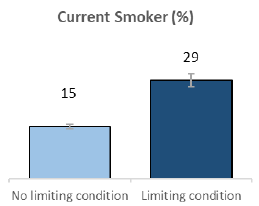
- Mental Wellbeing
Adults living with a limiting long-term condition scored lower in mental wellbeing than those without.
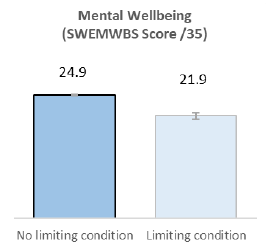
- Perception of Crime in Local Area
Adults with limiting long-term conditions were less likely to report that crime in their area had reduced or stayed the same.
Since 2016, there has been a reduction in this indicator for both groups but no change has occurred over the longer period (2012 to 2017).
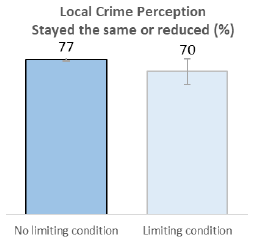
- Confidence in the Police
For adults with a limiting long-term health conditions, the proportion who were very or fairly confident in the ability of the police ranged from 51% to 65% across the six domains. In each domain, this group was 5 to 7 percentage points below those without a limiting long-term health condition.
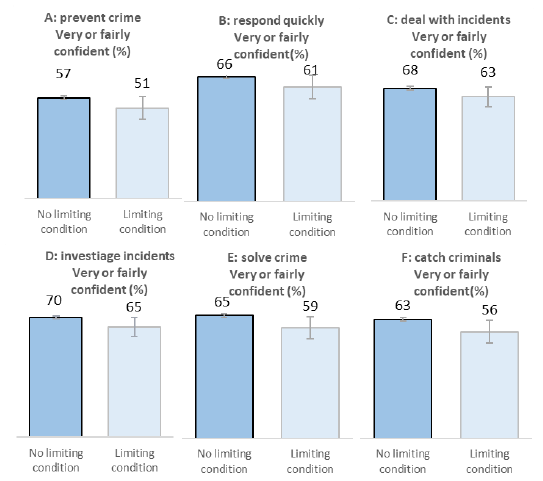
There were no significant differences between those with and without a limiting long-term health condition for unpaid care provision.
2.2 Ethnic group
The ethnic group of respondents is collected in detail by the surveys contributing to the SSCQ. The full range of responses available to survey respondents is provided in Table 21.
We have tried to present the data on ethnic group in a way that would be most helpful to users, with consideration to producing analysis to reveal inequalities. However, in Scotland, many ethnic groups are small in number which can often lead to statistical unreliability when analysing and presenting data drawn from a sample survey. This can hinder publication of detailed data because of the need to avoid the identification of individuals.
In some instances we have tried to overcome this problem by combining categories. This is not an ideal solution as it can hide inequalities that occur between each of the separate categories, but it is often the option which provides the best balance between data utility and the protection of the individual. Our schema for combining ethnicity categories is provided in section 6.7.
Where it has been necessary to combine categories, we have tried to make the headings reflective of the individual categories that have been combined. We have tried to take account of the sensitivities around differing stakeholders’ views of the ethnic group categories used in Scottish surveys. In the accompanying commentary we have used current terminology on ethnic group.
Table 2: Age profile of ethnic groups, SSCQ 2017
| Proportion in Age Group (Row %) | Adults | Col% | ||||||
|---|---|---|---|---|---|---|---|---|
| 16-24 | 25-34 | 35-44 | 45-54 | 55-64 | 65+ | |||
| White: Scottish | 13 | 15 | 13 | 18 | 17 | 24 | 3,470,897 | 77% |
| White: Other British | 11 | 14 | 15 | 18 | 17 | 25 | 546,454 | 12% |
| White: Polish | 15 | 43 | 34 | 7 | 1 | 1 | 88,532 | 2% |
| White: Other* | 18 | 28 | 22 | 12 | 8 | 13 | 197,101 | 4% |
| Asian** | 21 | 30 | 24 | 12 | 8 | 6 | 118,414 | 3% |
| All other ethnic groups*** | 16 | 31 | 27 | 17 | 6 | 3 | 78,491 | 2% |
*Section 6.7 provides the full schema for combining ethnicity categories.
- There were substantial differences in the age distribution of ethnic groups. While “White: Scottish” and “White: Other British” were very similar, other groups tend to be younger in general and to have a larger proportion of people aged 25-34.
Analysis
Where formal testing is conducted, “White: Scottish” is used as the reference category for comparison.
Due to the differences in age profiles of the two groups, age-standardisation is applied before comparisons are summarised below. For more information on age-standardisation, see section 6.9. For more information about statistical tests, see section 6.10.
Ethnicity - Findings (age-standardised)
- General Health
“White: Other British”, “White: Other” and “All other ethnic groups” reported higher good/very good general health than the “White: Scottish” reference group.
Since 2012, levels of good/very good general health have increased by 3.0 percentage points for the “White: Other British” group.
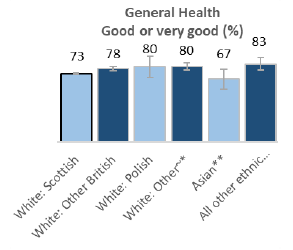
- Smoking
Adults whose ethnicity is “White: Other British” and “Asian” and “All other ethnic groups” reported a lower smoking prevalence than the “White: Scottish” group.
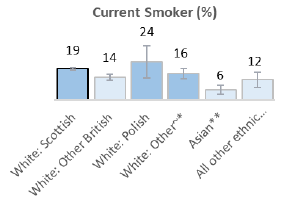
- Mental Wellbeing
Since 2014, there has been a reduction of 0.4 in the average mental wellbeing score of adults identifying as “White: Other British” to 24.3 in 2017.
- Unpaid Care
Lower proportions of “White: Other British” (16%), “White: Polish” (7%) and “White: Other” (9%) ethnic groups reported providing unpaid care than the “White: Scottish” reference group.
In the “White: Other” group, the proportion of adults providing unpaid care had fallen by 5.5 percentage points since 2014.
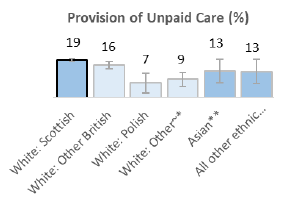
- Perception of Crime in Local Area
In the “White: Other British” group there is a higher proportion of adults who think that crime in their local area had fallen or stayed the same in the past two years (79%) than the “White: Scottish” reference group (75%).
- Confidence in the Police
In comparison to the “White: Scottish” reference group;
- “White: Polish” adults reported lower confidence in the ability of the police in three domains (D,E,F). In these domains those who were very or fairly confident in the ability of the police was below 50%, after age-standardisation.
- “White:Other British” adults reported higher confidence by between three and four percentage points in three domains (B,C,D).
- “White: Other” adults reported higher confidence by five percentage points in two domains (D,F).
Table 13 to Table 18 provide details of significant changes in the indicators since 2012 and 2016.
2.3 Religion
The religious group or denomination to which respondents report belonging is collected in detail by the contributing surveys to the SSCQ. The full range of responses available to respondents is provided in Table 20.
In some instances to overcome the problem of small groups we have combined categories. This is not an ideal solution as it can hide inequalities that occur between each of the separate categories, but it is often the option which provides the best balance between data utility, sensitivity and the protection of the individual. Our schema for doing so is provided in section 6.6.
Where it has been necessary to combine categories, we have tried to make the headings reflective of the individual categories that have been combined. We have tried to take account of the sensitivities around differing stakeholders’ views of the religious group categories used in Scottish surveys.
Table 3: Age profile of religion groups, SSCQ 2017
| Proportion in Age Group (Row %) | Adults | Col% | ||||||
|---|---|---|---|---|---|---|---|---|
| 16-24 | 25-34 | 35-44 | 45-54 | 55-64 | 65+ | |||
| None | 18 | 21 | 17 | 18 | 13 | 12 | 2,226,839 | 50% |
| Church of Scotland | 4 | 5 | 9 | 18 | 21 | 44 | 1,085,148 | 24% |
| Roman Catholic | 12 | 17 | 15 | 19 | 15 | 22 | 653,170 | 15% |
| Other Christian | 10 | 15 | 14 | 15 | 18 | 28 | 351,079 | 8% |
| Muslim | 19 | 29 | 26 | 13 | 8 | 5 | 70,766 | 2% |
| Other | 15 | 22 | 20 | 14 | 10 | 19 | 105,516 | 2% |
- Around 40% of those without religious affiliation were under 35.
- Over half of Muslims were under 35.
- Over 60% of Church of Scotland members were 55 or over.
Analysis
Where formal testing is conducted, the group without a religious affiliation (“None”) is used as the reference category for comparison.
Due to the differences in age profiles of the two groups, age-standardisation is applied before comparisons are summarised below. For more information on age-standardisation, see section 6.9. For more information about statistical tests, see section 6.10.
Religious Group - Findings (age-standardised)
- General Health
- Limiting Long-Term Conditions
In comparison to those with no religious affiliation:
- A lower proportion of “other” religious groups reported good/very good general health and a higher proportion reported having a limiting long-term condition.
- “Other Christian”s reported a higher level of good/very good general health than the ‘no religion’ reference group.
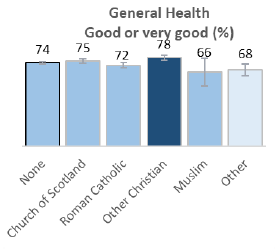
Limiting long-term conditions in “Other: Christian”s has increased by 3.9 percentage points since 2016, to 26%.
- Smoking
Smoking rates were lower for adults who identified as “Muslim”, “Other Christian” and “Church of Scotland” than the “no religion” reference group.
Those who have “no religion” and who identified as belonging to “Church of Scotland”, “Roman Catholic” and “Other Christian” groups have seen reductions in smoking rates since 2012.
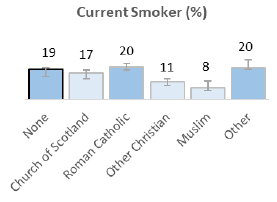
- Mental Wellbeing
The “Roman Catholic” (24.4) and “Other Christian” (24.7) groups reported higher mental wellbeing scores than the “No religion” (24.1) reference group.
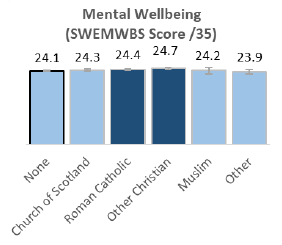
- Unpaid Care
Those reporting as belonging to “Church of Scotland” (19%) appear more likely to provide unpaid care than adults with no religious affiliation (16%).
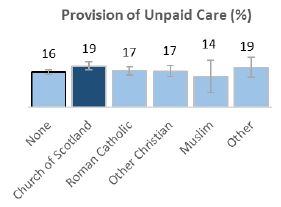
- Confidence in the Police
In comparison to those with no religious afiliation;
- Those reporting as belonging to the “Church of Scotland” reported higher confidence in the ablilty of the police by between three and five percentage points in four of the six domains (C,D,E,F).
- “Other Christian”s reported higher confidence in the police to deal with incidents as they occur (C) by three percentage points and to solve crimes (E) by six percentage points.
Since 2012, those reporting as belonging to the “Church of Scotland” have reduced confidence in the police in three domains (A,B,C), falling by 4.4, 1.9 and 2.6 percentage points respectively. In the these domains the proportion of those very or fairly confident remains over 50% in 2017.
There were no significant differences between “no religion” and all other religious groups for perception of crime in local area and confidence in the police to respond quickly to appropriate information (B).
2.4 Sexual orientation
Self-identified sexual orientation was introduced to Scottish government surveys to underpin the equality monitoring responsibilities of public sector organisations and to assess the disadvantage or relative discrimination experienced by the lesbian, gay and bisexual population.
It is felt that the figures are likely to under-report the percentage of those who identify as lesbian, gay or bisexual (LGB) within society due to a number of reasons, including the following:
- Asking about sexual orientation/identity is a relatively new development in national surveys and such questions can be seen as intrusive and personal.
- There is still prejudice and discrimination against those who identify as LGB in society. In a context where some will not have told friends and family about their sexual identity, there is a real question about whether they generally would want to be open with an interviewer.
- The default option for being uncertain about one's sexual orientation may be to respond 'straight/heterosexual' rather than to say 'don’t know/not sure'.
- Particular adults who identify as LGB are still less likely to be open where they belong to groups or communities where an LGB identity is less acceptable.
For these reasons, analysis of the SSCQ estimate on LGB & Other should not be treated as a defintive measure but does provide useful insight into the difference between sexual orientation groups. Due to the small number of adults reporting their sexual orientation as lesbian, gay, bisexual or other, it is necessary to group these individuals together.
Table 4: Age profile of sexual orientation groups, SSCQ 2017
| Proportion in Age Group (Row %) | Adults | Col% | ||||||
|---|---|---|---|---|---|---|---|---|
| 16-24 | 25-34 | 35-44 | 45-54 | 55-64 | 65+ | |||
| Heterosexual | 13 | 16 | 15 | 18 | 16 | 23 | 4,259,476 | 97% |
| LGB & Other | 29 | 24 | 14 | 15 | 9 | 8 | 110,083 | 3% |
- The changing attitudes towards sexual orientation are at least partly reflected in the age distribution of the LGB & Other group versus those identifying as heterosexual.
- Half of those identifying as LGB & Other were under 35. Under ten percent of the LGB & Other group were aged 65+, compared with over twenty percent of those identifying as heterosexual.
Analysis
Where formal testing is conducted, those identifying as “Heterosexual” is used as the reference category for comparison.
Due to the differences in age profiles of the two groups, age-standardisation is applied before comparisons are summarised below. For more information on age-standardisation, see section 6.9. For more information about statistical tests, see section 6.10.
Sexual Orientation - Findings (age-standardised)
- Limiting Long-Term Conditions
Adults identifying as “LGB & Other” reported a higher prevalence of limiting long-term health conditions (29%), than those identifying as “Heterosexual” (23%).
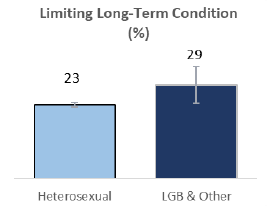
- Smoking
Adults idenfiying as “LGB & Other” reported a higher smoking rate (24%) than those identfying as “Heterosexual” (18%).
Both groups have seen a reduction from previous years, with the “LGB & Other” group falling by 11.5 percentage points and the “Heterosexual” group falling by 6.0 percentage points since 2012.
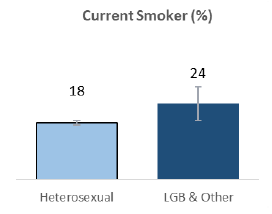
- Mental Wellbeing
Adults identifying as “LGB & Other” scored lower in mental wellbeing than those identifying as “Heterosexual” (0.8 lower after age-standardisation).
Mental wellbeing has fallen by a score of 0.2 for the “Heterosexual” group since 2012
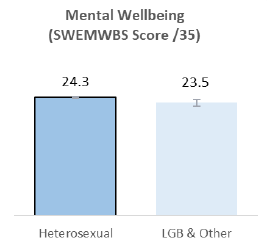
There were no significant differences between sexual orientation groups for general health, unpaid care provision, perception of crime in local area and any of the confidence in the police domains.
2.5 Age and Gender
SSCQ data is calibrated to reflect annual population estimates from the National Records of Scotland. The distribution from the survey therefore mirrors the published figures at Local Authority level from NRS.
Age and gender are determining factors across most indicators in the SSCQ.
Analysis
Where formal testing is conducted, the median age group (45-54) and gender “Men” are used as the reference category for comparison. No age-standardisation has been applied to analysis in this section.
For more information about statistical tests, see section 6.10.
Age Group - Summary Findings
- General Health
- Limiting Long-Term Conditions
With increasing age, adults (16+) were more likely to report having a limiting long-term condition and less likely to report good/very good general health.
There has been an upward trend in the proportion of younger adults with limiting long-term health conditions, with the proportion in the 16-24 age group increasing by 5.0 percentage points since 2012.
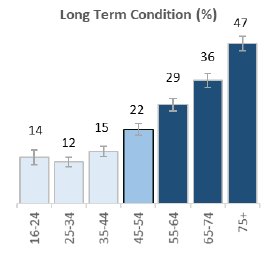
- Smoking
Smoking was not as prevalent amongst older age groups. Those aged 65 or over reported lower smoking rates than the median age group. Age groups between 25 and 54 reported similar levels to each other (between 19% and 22%).
Low prevalence in older age groups is likely due to changes in habit with age and/or premature deaths among smokers.
Since 2012, there have been clear reductions in all age groups other than 75+.
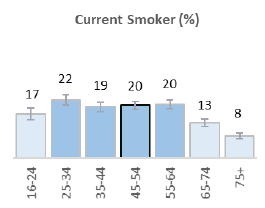
- Unpaid Care
The proportion of all adults providing unpaid care was highest between the ages of 45 and 64, where almost a quarter of people provide unpaid care.
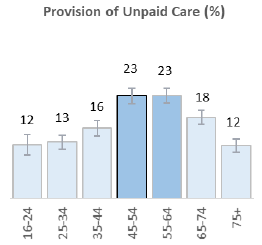
Confidence in the Police
In general, confidence in the ability of the police fell with age. Higher levels of confidence were reported among 16-24 year olds with the lowest levels in the 65-74 age group. Confidence levels were somewhat higher in the 75+ age group.
Since 2012, among those aged 65-74, fewer reported confidence in the police in four domains (A,B,C,D). Though this is often the least confident age group, the majority of this group remain very or fairly confident in the ability of the police.
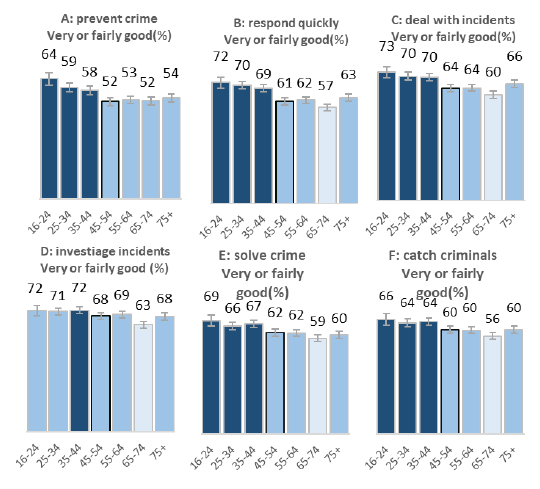
Gender - Summary Findings
- General Health
- Limiting Long-Term Conditions
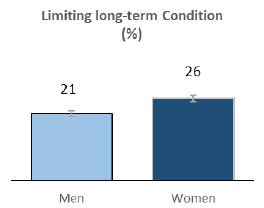
A higher proportion of women (26%) reported living with a limiting long-term health condition compared to men (21%).
Women were less likely to report to be in good or very good general health in comparison to men, with a gap of 2.8 percentage points between the two groups.
Smoking
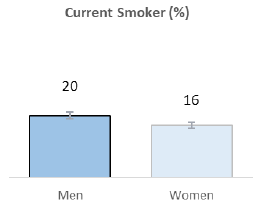
Smoking rates among women were three percentage points lower than for men.
Unpaid Care
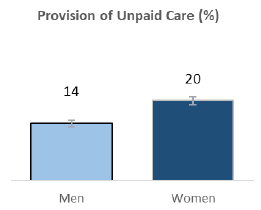
Unpaid care was provided by fewer men (14%) than women (20%).
Perception of Crime in Local Area
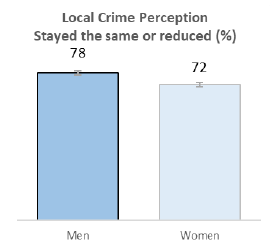
Men (78%) were more likely than women (72%) to report that crime had reduced or stayed the same in their local area over the previous two years.
Contact
Email: sscq@gov.scot
There is a problem
Thanks for your feedback